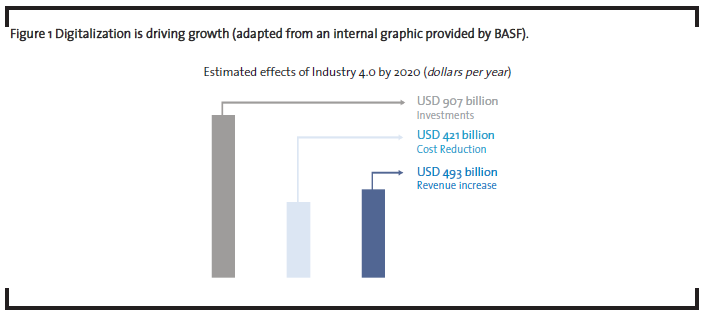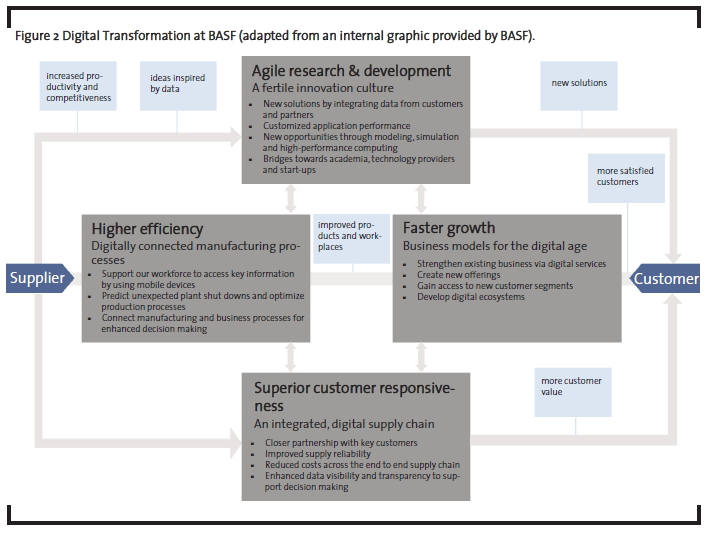Digitalization of the chemical industry
The chemical industry – much like all other industries as well – has entered the digital age. The targeted use of data in order to create growth or increase efficiencies is at the very core of digitalization. The term “data is the new oil” describes the strategic importance of access to data, skills to store and process it and to turn it into valuable customercentric solutions.
Key trends like an ever-rising connectivity, increasing transparency, quantification and profiling as well as mass customization impact the way business is done. These trends are fueled by technological step changes in computing speed, data storage and mobile data transmission rates – to name but a few.
Chemical companies have embraced this development at a later stage than many other industries. They often operate several market steps away from end consumers who are closely linked to some of the key digital trends. Additionally, enterprises place a high value on safety and security issues due to the nature of chemical production (e.g., toxicity, risk of explosion, dual use) – a concern that has impacted the development speed of data-driven applications in the IT and OT (Operations Technology) environment of these companies.
The anticipated potential of digitalization in the chemical industry is high (see figure 1). Revenue growth of 3.1% p.a. and cost reductions of 4.2% p.a. are quoted in a PWC study (2016) focusing on digital business models, smart supply chain solutions, smart manufacturing applications and a digitalized R&D as sources of such opportunities. Lifting this potential requires the skilled use of digital core technologies and foremost the readiness of an entire company for a digital transformation.
Digital core technologies typically include cloud technology, IoT (internet of things), big data analytics, mobility devices, augmented reality and artificial intelligence. Depending on the industry context 3D printing and robotics can be added to this non-comprehensive list. All of them are enabling companies to create solutions that differ from the status quo of running supply chains, production, R&D, marketing and sales.
Readiness of a chemical company to drive a digital transformation can be linked to four different factors:
- Digitalization is reflected in the corporate strategy
- Organizational structure embeds digital roles & responsibilities in a sustainable way
- IT systems support agile solutions and safeguard the company with a resilience-based security system
- Corporate culture embraces iterative improvements, agility and data literacy
BASF has included digitally enabled solutions, horizontal and vertical connectivity as well as workforce enablement to recognize and capture the value of data in its Digital Vision (see figure 2). Based on this vision more than 15 lighthouse projects with a dedicated business case were generated in 2015, followed by a total of more than 100 projects in 2016/17. A few examples can showcase this approach.
Digital Business Model: OASE connect.
In the near future, BASF will be able to support customers in the gas treatment business through the OASE connect online platform. With the help of the platform, the business team strengthens its service and offers BASF’s customers real-time access to important information. The functionalities include, for example, a software that helps customers find the optimum settings for their system and adjust important parameters accordingly. Depending on the need, customers can use one or more OASE connect functions. BASF is currently testing the offer together with some of its customers. Their feedback is used to develop and further enhance the software.
Smart Innovations.
In catalyst research, BASF implements quick tests based on mathematic models and experiments. A much simpler view of complex connections through networked data structures is the result. This enables BASF scientists to test hypotheses much earlier and in a much more targeted manner, making better use of innovation opportunities and shortening development time.
For automotive paints, BASF uses real time data from customers’ painting line to optimally adjust the color based on customer needs. This allows BASF to ensure that the vehicle is painted in exactly the right color in a shorter amount of time.
In enzyme research, BASF has combined its own and external information into huge data records. On this basis, and using simple tools, researchers can quickly identify the most promising candidates for further development.
Smart Manufacturing.
BASF’s Ludwigshafen Verbund needs roughly 20 million metric tons of steam per year, which are generated by the production plants and the site’s three power plants. In addition, the power plants produce the majority of electricity needed at the site – and sometimes more than is required, so that electricity can be fed into the public grid.
However, electricity is a complex business as market prices fluctuate every 15 minutes. Computer programs help to buy and sell at the best times. For this, however, a precise forecast is required as to how much steam and waste heat the production plants supply at the site, how much steam the power plants have to contribute and how much electricity is needed. This also fluctuates depending on the time of year, the weather and the economic conditions.
To date, the total requirements have been determined manually combined individual forecasts of the plants. A new statistical model, based on large amounts of data, now provides even more precise calculations: The software takes into account, among other things, historical and up-to-date information on production shutdowns, weather data and economic indices. The program searches for relationships and establishes connections with the energy demand.
This has been very successful: The forecast for steam demand has already improved by up to 60 percent. The former procedure will now be gradually replaced and applied to other areas. The new program supports BASF also in electricity trading to make better price forecasts.
These use cases demonstrate the potential of digitalization in a chemical industrial context. Making digital transformation a key priority of the CEO is paramount to a successful implementation. BASF has started a journey that builds awareness, understanding, practical skills and good practice sharing amongst all employees. Different formats and messages are used to reach a broad range of communities with the overarching claim “We have a challenging route ahead but the confidence of the right direction”.
Digitalization is here to stay. It is in everyone’s hands to contribute to its shaping.
References
PWC (2016): Industry 4.0: Building the digital enterprise: Forest, paper and packaging key findings, 2016 Global Industry 4 .0 Survey – Industry key findings, p. 5

